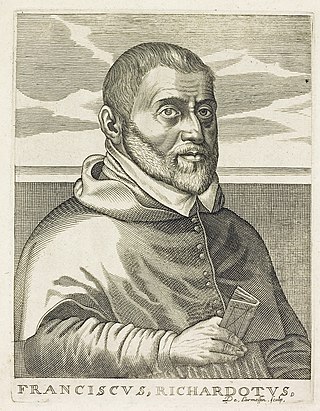Related Research Articles

Blaise de Vigenère was a French diplomat, cryptographer, translator and alchemist.

François Richardot (Franciscus) (1507-1574), was a celebrated Burgundian-French Catholic preacher, and confessor to Margaret of Parma. He was Bishop of Arras from 1561 to 1574.

The Diocese of Arras (–Boulogne–Saint-Omer) is a Latin Church diocese of the Catholic Church in France. The episcopal see is the Arras Cathedral, in the city of Arras. The diocese encompasses all of the Department of Pas-de-Calais, in the Region of Hauts-de-France.
Raimond de Beccarie de Pavie, baron (Seigneur) de Fourquevaux was a French soldier, politician, and diplomat.
Jean-Baptiste Gramaye was an early modern historian of the Southern Netherlands. He studied law and became a professor at Leuven University. Later he was employed as court historian by Albert VII, Archduke of Austria. For five months in 1619 he was a prisoner in Barbary, an experience that changed the focus of his scholarship from the Low Countries to Africa.

Rutger Velpius was a 16th- and 17th-century printer and bookseller. He was the first printer in the city of Mons, and later became printer to the court in Brussels. His career coincided closely with the first decades of the Dutch Revolt
Events from the 1580s in the Spanish Netherlands and Prince-bishopric of Liège.
Nicolas de Montmorency, count of Estaires, was an office holder and spiritual author in the Spanish Netherlands.
Guillaume Gazet, Latinized Gulielmus Gazaeus (1554–1612) was a poet and ecclesiastical historian in the Spanish Netherlands. His brother, Antoine Gazet, was a physician and translator.
Floris Van der Haer, also known as Florentius Haracus, (1547–1634) was a clergyman from the Habsburg Netherlands and an author of historical works.
François Pollet was a lawyer from Douai, then in the County of Flanders.
Events in the year 1635 in the Spanish Netherlands and Prince-bishopric of Liège.

The Treaty of Arras of 17 May 1579 was a peace treaty concluded between the Spanish Crown, represented by Alexander Farnese, Duke of Parma, and representatives of the County of Hainaut, the County of Artois, and the cities of Douai, Lille, Orchies and Arras, all members of the Union of Arras, that had been formed on the 6 January 1579.
Events in the year 1601 in the Spanish Netherlands and Prince-bishopric of Liège.
Fulvio Androzzi or Androzio (1523–1575) was an Italian Jesuit and author of devotional literature.
Mathieu Moulart (1536–1600), alternatively Moullart or Moulard, was an abbot and bishop in the Habsburg Netherlands.
Michel d'Esne de Betencourt (1540–1614) was a prelate in the Habsburg Netherlands.
Balthasar or Balthazar Bellerus or Bellère was a printer first at Antwerp and later at Douai in the Habsburg Netherlands. He was a son of the reputable Antwerp printer Joannes Bellerus, and set up a printing shop of his own in the Rue des Ecoles in Douai in 1590, becoming a colleague and rival to Jan Bogard. The motto that appeared on his printer's mark was Labore ac perseverantiâ. His marks were the golden compass and a unicorn dipping its horn in a stream.
Antoine Gazet was a physician and translator in the Habsburg Netherlands. He was born in Aire-sur-la-Lys around the middle of the 16th century and was educated at least in part in Italy. After returning from Italy he lived for several years in Aire, where his presence is attested in the parish records of Saint-Pierre d'Aire up to 1610. He was the brother of the poet and ecclesiastical historian Guillaume Gazet.
Jean Gesse, known as Jean de La Gessée, born in Mauvezin in Gascony around 1550 and died around 1600, was a French poet, historian and genealogist.
References
- 1 2 3 E.-H.-J. Reusens, "Bogard (Jean)", Biographie Nationale de Belgique , vol. 2 (Brussels, 1868), 615-616.
- ↑ Petit traicté on Google Books
- ↑ De Fugienda on Google Books
- ↑ Quatre sermons on Google Books
- ↑ In Omnes Epistolas on Google Books
- ↑ Historia Fori Romani on Google Books
- ↑ Le pérégrination on Google Books
- ↑ Opera on Google Books
- ↑ Recueil des lettres on Google Books
- ↑ Traicte de reconciliation on Google Books
- ↑ L'anatomie du corps politique on Google Books
- ↑ De initiis on Google Books
- ↑ Le memorial on Google Books
- ↑ Lettres missives on Google Books
- ↑ Les trois livres on Google Books.
- ↑ Lettre du Japon on Google Books
- ↑ Andrew Pettegree and Malcolm Walsby (eds), Netherlandish Books: Books Published in the Low Countries and Dutch Books Printed Abroad before 1601, vol. 1 (Leiden, Brill, 2011), p. 45.
- ↑ Chronicon Cameracense et Atrebatense on Google Books
- ↑ Rerum Duacensium on Google Books